[English] 日本語
 Yorodumi
Yorodumi- PDB-5aj0: Cryo electron microscopy of actively translating human polysomes ... -
+ Open data
Open data
- Basic information
Basic information
| Entry | Database: PDB / ID: 5aj0 | ||||||
|---|---|---|---|---|---|---|---|
| Title | Cryo electron microscopy of actively translating human polysomes (POST state). | ||||||
 Components Components |
| ||||||
 Keywords Keywords |  RIBOSOME / MAMMALIAN RIBOSOME / RIBOSOME / MAMMALIAN RIBOSOME /  TRANSLATION / TRANSLATION /  POLYSOME / CRYO ELECTRON MICROSCOPY / ELONGATION CYCLE POLYSOME / CRYO ELECTRON MICROSCOPY / ELONGATION CYCLE | ||||||
| Function / homology |  Function and homology information Function and homology informationpositive regulation of cysteine-type endopeptidase activity involved in execution phase of apoptosis / negative regulation of endoplasmic reticulum unfolded protein response / embryonic brain development / oxidized pyrimidine DNA binding / response to TNF agonist / positive regulation of base-excision repair / eukaryotic 80S initiation complex / protein tyrosine kinase inhibitor activity / negative regulation of protein neddylation /  translation at presynapse ...positive regulation of cysteine-type endopeptidase activity involved in execution phase of apoptosis / negative regulation of endoplasmic reticulum unfolded protein response / embryonic brain development / oxidized pyrimidine DNA binding / response to TNF agonist / positive regulation of base-excision repair / eukaryotic 80S initiation complex / protein tyrosine kinase inhibitor activity / negative regulation of protein neddylation / translation at presynapse ...positive regulation of cysteine-type endopeptidase activity involved in execution phase of apoptosis / negative regulation of endoplasmic reticulum unfolded protein response / embryonic brain development / oxidized pyrimidine DNA binding / response to TNF agonist / positive regulation of base-excision repair / eukaryotic 80S initiation complex / protein tyrosine kinase inhibitor activity / negative regulation of protein neddylation /  translation at presynapse / positive regulation of intrinsic apoptotic signaling pathway in response to DNA damage / positive regulation of respiratory burst involved in inflammatory response / positive regulation of gastrulation / axial mesoderm development / regulation of G1 to G0 transition / negative regulation of formation of translation preinitiation complex / IRE1-RACK1-PP2A complex / nucleolus organization / translation at presynapse / positive regulation of intrinsic apoptotic signaling pathway in response to DNA damage / positive regulation of respiratory burst involved in inflammatory response / positive regulation of gastrulation / axial mesoderm development / regulation of G1 to G0 transition / negative regulation of formation of translation preinitiation complex / IRE1-RACK1-PP2A complex / nucleolus organization /  ribosomal protein import into nucleus / positive regulation of intrinsic apoptotic signaling pathway in response to DNA damage by p53 class mediator / regulation of translation involved in cellular response to UV / response to extracellular stimulus / positive regulation of endodeoxyribonuclease activity / positive regulation of Golgi to plasma membrane protein transport / exit from mitosis / protein-DNA complex disassembly / TNFR1-mediated ceramide production / 90S preribosome assembly / positive regulation of DNA damage response, signal transduction by p53 class mediator resulting in transcription of p21 class mediator / negative regulation of DNA repair / negative regulation of RNA splicing / optic nerve development / TORC2 complex binding / oxidized purine DNA binding / negative regulation of intrinsic apoptotic signaling pathway in response to hydrogen peroxide / ribosomal protein import into nucleus / positive regulation of intrinsic apoptotic signaling pathway in response to DNA damage by p53 class mediator / regulation of translation involved in cellular response to UV / response to extracellular stimulus / positive regulation of endodeoxyribonuclease activity / positive regulation of Golgi to plasma membrane protein transport / exit from mitosis / protein-DNA complex disassembly / TNFR1-mediated ceramide production / 90S preribosome assembly / positive regulation of DNA damage response, signal transduction by p53 class mediator resulting in transcription of p21 class mediator / negative regulation of DNA repair / negative regulation of RNA splicing / optic nerve development / TORC2 complex binding / oxidized purine DNA binding / negative regulation of intrinsic apoptotic signaling pathway in response to hydrogen peroxide /  supercoiled DNA binding / supercoiled DNA binding /  GAIT complex / G1 to G0 transition / neural crest cell differentiation / retinal ganglion cell axon guidance / GAIT complex / G1 to G0 transition / neural crest cell differentiation / retinal ganglion cell axon guidance /  NF-kappaB complex / rRNA modification in the nucleus and cytosol / negative regulation of phagocytosis / middle ear morphogenesis / ubiquitin-like protein conjugating enzyme binding / regulation of establishment of cell polarity / positive regulation of ubiquitin-protein transferase activity / Formation of the ternary complex, and subsequently, the 43S complex / laminin receptor activity / erythrocyte homeostasis / cytoplasmic side of rough endoplasmic reticulum membrane / A band / positive regulation of signal transduction by p53 class mediator / ubiquitin ligase inhibitor activity / alpha-beta T cell differentiation / NF-kappaB complex / rRNA modification in the nucleus and cytosol / negative regulation of phagocytosis / middle ear morphogenesis / ubiquitin-like protein conjugating enzyme binding / regulation of establishment of cell polarity / positive regulation of ubiquitin-protein transferase activity / Formation of the ternary complex, and subsequently, the 43S complex / laminin receptor activity / erythrocyte homeostasis / cytoplasmic side of rough endoplasmic reticulum membrane / A band / positive regulation of signal transduction by p53 class mediator / ubiquitin ligase inhibitor activity / alpha-beta T cell differentiation /  pigmentation / pigmentation /  protein kinase A binding / negative regulation of ubiquitin protein ligase activity / Ribosomal scanning and start codon recognition / ion channel inhibitor activity / Translation initiation complex formation / phagocytic cup / positive regulation of mitochondrial depolarization / response to aldosterone / negative regulation of Wnt signaling pathway / homeostatic process / positive regulation of T cell receptor signaling pathway / lung morphogenesis / macrophage chemotaxis / positive regulation of activated T cell proliferation / protein kinase A binding / negative regulation of ubiquitin protein ligase activity / Ribosomal scanning and start codon recognition / ion channel inhibitor activity / Translation initiation complex formation / phagocytic cup / positive regulation of mitochondrial depolarization / response to aldosterone / negative regulation of Wnt signaling pathway / homeostatic process / positive regulation of T cell receptor signaling pathway / lung morphogenesis / macrophage chemotaxis / positive regulation of activated T cell proliferation /  fibroblast growth factor binding / fibroblast growth factor binding /  regulation of cell division / SARS-CoV-1 modulates host translation machinery / regulation of cell division / SARS-CoV-1 modulates host translation machinery /  iron-sulfur cluster binding / iron-sulfur cluster binding /  Protein hydroxylation / Protein hydroxylation /  TOR signaling / TOR signaling /  BH3 domain binding / mTORC1-mediated signalling / endonucleolytic cleavage to generate mature 3'-end of SSU-rRNA from (SSU-rRNA, 5.8S rRNA, LSU-rRNA) / Peptide chain elongation / Selenocysteine synthesis / protein-RNA complex assembly / monocyte chemotaxis / cysteine-type endopeptidase activator activity involved in apoptotic process / Formation of a pool of free 40S subunits / BH3 domain binding / mTORC1-mediated signalling / endonucleolytic cleavage to generate mature 3'-end of SSU-rRNA from (SSU-rRNA, 5.8S rRNA, LSU-rRNA) / Peptide chain elongation / Selenocysteine synthesis / protein-RNA complex assembly / monocyte chemotaxis / cysteine-type endopeptidase activator activity involved in apoptotic process / Formation of a pool of free 40S subunits /  ribosomal small subunit export from nucleus / positive regulation of cyclic-nucleotide phosphodiesterase activity / Eukaryotic Translation Termination / blastocyst development / Response of EIF2AK4 (GCN2) to amino acid deficiency / SRP-dependent cotranslational protein targeting to membrane / translation regulator activity / positive regulation of intrinsic apoptotic signaling pathway by p53 class mediator / Viral mRNA Translation / protein localization to nucleus / Nonsense Mediated Decay (NMD) independent of the Exon Junction Complex (EJC) / cellular response to actinomycin D / GTP hydrolysis and joining of the 60S ribosomal subunit / negative regulation of proteasomal ubiquitin-dependent protein catabolic process / negative regulation of respiratory burst involved in inflammatory response ribosomal small subunit export from nucleus / positive regulation of cyclic-nucleotide phosphodiesterase activity / Eukaryotic Translation Termination / blastocyst development / Response of EIF2AK4 (GCN2) to amino acid deficiency / SRP-dependent cotranslational protein targeting to membrane / translation regulator activity / positive regulation of intrinsic apoptotic signaling pathway by p53 class mediator / Viral mRNA Translation / protein localization to nucleus / Nonsense Mediated Decay (NMD) independent of the Exon Junction Complex (EJC) / cellular response to actinomycin D / GTP hydrolysis and joining of the 60S ribosomal subunit / negative regulation of proteasomal ubiquitin-dependent protein catabolic process / negative regulation of respiratory burst involved in inflammatory responseSimilarity search - Function | ||||||
| Biological species |   Homo sapiens (human) Homo sapiens (human)  Yersinia pseudotuberculosis (bacteria) Yersinia pseudotuberculosis (bacteria) | ||||||
| Method |  ELECTRON MICROSCOPY / ELECTRON MICROSCOPY /  single particle reconstruction / single particle reconstruction /  cryo EM / Resolution: 3.5 Å cryo EM / Resolution: 3.5 Å | ||||||
 Authors Authors | Behrmann, E. / Loerke, J. / Budkevich, T.V. / Yamamoto, K. / Schmidt, A. / Penczek, P.A. / Vos, M.R. / Burger, J. / Mielke, T. / Scheerer, P. / Spahn, C.M.T. | ||||||
 Citation Citation |  Journal: Cell / Year: 2015 Journal: Cell / Year: 2015Title: Structural snapshots of actively translating human ribosomes. Authors: Elmar Behrmann / Justus Loerke / Tatyana V Budkevich / Kaori Yamamoto / Andrea Schmidt / Pawel A Penczek / Matthijn R Vos / Jörg Bürger / Thorsten Mielke / Patrick Scheerer / Christian M T Spahn /    Abstract: Macromolecular machines, such as the ribosome, undergo large-scale conformational changes during their functional cycles. Although their mode of action is often compared to that of mechanical ...Macromolecular machines, such as the ribosome, undergo large-scale conformational changes during their functional cycles. Although their mode of action is often compared to that of mechanical machines, a crucial difference is that, at the molecular dimension, thermodynamic effects dominate functional cycles, with proteins fluctuating stochastically between functional states defined by energetic minima on an energy landscape. Here, we have used cryo-electron microscopy to image ex-vivo-derived human polysomes as a source of actively translating ribosomes. Multiparticle refinement and 3D variability analysis allowed us to visualize a variety of native translation intermediates. Significantly populated states include not only elongation cycle intermediates in pre- and post-translocational states, but also eEF1A-containing decoding and termination/recycling complexes. Focusing on the post-translocational state, we extended this assessment to the single-residue level, uncovering striking details of ribosome-ligand interactions and identifying both static and functionally important dynamic elements. | ||||||
| History |
| ||||||
| Remark 700 | SHEET DETERMINATION METHOD: DSSP THE SHEETS PRESENTED AS "BA" IN EACH CHAIN ON SHEET RECORDS BELOW ...SHEET DETERMINATION METHOD: DSSP THE SHEETS PRESENTED AS "BA" IN EACH CHAIN ON SHEET RECORDS BELOW IS ACTUALLY AN 6-STRANDED BARREL THIS IS REPRESENTED BY A 7-STRANDED SHEET IN WHICH THE FIRST AND LAST STRANDS ARE IDENTICAL. SHEET DETERMINATION METHOD: DSSP THE SHEETS PRESENTED AS "VB" IN EACH CHAIN ON SHEET RECORDS BELOW IS ACTUALLY AN 5-STRANDED BARREL THIS IS REPRESENTED BY A 6-STRANDED SHEET IN WHICH THE FIRST AND LAST STRANDS ARE IDENTICAL. SHEET DETERMINATION METHOD: DSSP THE SHEETS PRESENTED AS "FA" IN EACH CHAIN ON SHEET RECORDS BELOW IS ACTUALLY AN 6-STRANDED BARREL THIS IS REPRESENTED BY A 7-STRANDED SHEET IN WHICH THE FIRST AND LAST STRANDS ARE IDENTICAL. |
- Structure visualization
Structure visualization
| Movie |
 Movie viewer Movie viewer |
|---|---|
| Structure viewer | Molecule:  Molmil Molmil Jmol/JSmol Jmol/JSmol |
- Downloads & links
Downloads & links
- Download
Download
| PDBx/mmCIF format |  5aj0.cif.gz 5aj0.cif.gz | 4.8 MB | Display |  PDBx/mmCIF format PDBx/mmCIF format |
|---|---|---|---|---|
| PDB format |  pdb5aj0.ent.gz pdb5aj0.ent.gz | Display |  PDB format PDB format | |
| PDBx/mmJSON format |  5aj0.json.gz 5aj0.json.gz | Tree view |  PDBx/mmJSON format PDBx/mmJSON format | |
| Others |  Other downloads Other downloads |
-Validation report
| Arichive directory |  https://data.pdbj.org/pub/pdb/validation_reports/aj/5aj0 https://data.pdbj.org/pub/pdb/validation_reports/aj/5aj0 ftp://data.pdbj.org/pub/pdb/validation_reports/aj/5aj0 ftp://data.pdbj.org/pub/pdb/validation_reports/aj/5aj0 | HTTPS FTP |
|---|
-Related structure data
| Related structure data |  2875MUC  2902C  2903C  2904C  2905C  2906C  2907C  2908C  2909C  2910C  2911C M: map data used to model this data U: unfit; in different coordinate system*YM C: citing same article ( |
|---|---|
| Similar structure data |
- Links
Links
- Assembly
Assembly
| Deposited unit | 
|
|---|---|
| 1 |
|
- Components
Components
-RNA chain , 6 types, 7 molecules A3A4A2B1BvBwBx
| #1: RNA chain |  Mass: 62616.344 Da / Num. of mol.: 1 / Source method: isolated from a natural source / Source: (natural)   Homo sapiens (human) / Cell line: HEK 293T / References: Homo sapiens (human) / Cell line: HEK 293T / References:  GenBank: 51477016 GenBank: 51477016 | ||
|---|---|---|---|
| #2: RNA chain |  Mass: 38998.078 Da / Num. of mol.: 1 / Source method: isolated from a natural source / Source: (natural)   Homo sapiens (human) / Cell line: HEK 293T / References: Homo sapiens (human) / Cell line: HEK 293T / References:  GenBank: 23898 GenBank: 23898 | ||
| #48: RNA chain |  Mass: 1627178.625 Da / Num. of mol.: 1 / Source method: isolated from a natural source / Source: (natural)   Homo sapiens (human) / Cell line: HEK 293T / References: Homo sapiens (human) / Cell line: HEK 293T / References:  GenBank: 337381 GenBank: 337381 | ||
| #49: RNA chain |  Mass: 602776.875 Da / Num. of mol.: 1 / Source method: isolated from a natural source / Source: (natural)   Homo sapiens (human) / Cell line: HEK 293T / References: Homo sapiens (human) / Cell line: HEK 293T / References:  GenBank: 36162 GenBank: 36162 | ||
| #83: RNA chain |  Transfer RNA Transfer RNAMass: 24485.539 Da / Num. of mol.: 2 / Source method: isolated from a natural source / Details: MIXTURE OF ALL ENDOGENOUS PRESENT / Source: (natural)   Yersinia pseudotuberculosis (bacteria) / Cell line: HEK 293T / References: Yersinia pseudotuberculosis (bacteria) / Cell line: HEK 293T / References:  GenBank: 755367513 GenBank: 755367513#84: RNA chain | |  Messenger RNA Messenger RNAMass: 8527.686 Da / Num. of mol.: 1 / Source method: isolated from a natural source / Details: MIXTURE OF ALL ENDOGENOUS PRESENT / Source: (natural)   Homo sapiens (human) / Cell line: HEK 293T Homo sapiens (human) / Cell line: HEK 293T |
+60S ribosomal protein ... , 43 types, 43 molecules AAABACADAEAFAGAHAIAJALAMANAOAPAQARASATAUAVAWAXAYAZAaAbAcAdAe...
-Protein , 4 types, 4 molecules AKAmBfBg
| #13: Protein |  / 60S ribosomal protein L10E / 60S ribosomal protein L10EMass: 34309.418 Da / Num. of mol.: 1 / Source method: isolated from a natural source / Source: (natural)   Homo sapiens (human) / Cell line: HEK 293T / References: UniProt: P05388 Homo sapiens (human) / Cell line: HEK 293T / References: UniProt: P05388 |
|---|---|
| #41: Protein | Mass: 14758.394 Da / Num. of mol.: 1 / Source method: isolated from a natural source / Source: (natural)   Homo sapiens (human) / Cell line: HEK 293T / References: UniProt: P62987 Homo sapiens (human) / Cell line: HEK 293T / References: UniProt: P62987 |
| #81: Protein | Mass: 18004.041 Da / Num. of mol.: 1 / Source method: isolated from a natural source / Source: (natural)   Homo sapiens (human) / Cell line: HEK 293T / References: UniProt: P62979 Homo sapiens (human) / Cell line: HEK 293T / References: UniProt: P62979 |
| #82: Protein | Mass: 35115.652 Da / Num. of mol.: 1 / Source method: isolated from a natural source / Source: (natural)   Homo sapiens (human) / Cell line: HEK 293T / References: UniProt: P63244 Homo sapiens (human) / Cell line: HEK 293T / References: UniProt: P63244 |
+40S ribosomal protein ... , 31 types, 31 molecules BABBBCBDBEBFBGBHBIBJBKBLBMBNBOBPBQBRBSBTBUBVBWBXBYBZBaBbBcBdBe
-Protein/peptide , 1 types, 1 molecules By
| #85: Protein/peptide | Mass: 2060.531 Da / Num. of mol.: 1 / Source method: isolated from a natural source / Details: MIXTURE OF ALL ENDOGENOUS PRESENT / Source: (natural)   Homo sapiens (human) / Cell line: HEK 293T Homo sapiens (human) / Cell line: HEK 293T |
|---|
-Non-polymers , 2 types, 331 molecules 


| #86: Chemical | ChemComp-MG / #87: Chemical | ChemComp-ZN / |
|---|
-Details
| Sequence details | CGCGACCUCA |
|---|
-Experimental details
-Experiment
| Experiment | Method:  ELECTRON MICROSCOPY ELECTRON MICROSCOPY |
|---|---|
| EM experiment | Aggregation state: PARTICLE / 3D reconstruction method:  single particle reconstruction single particle reconstruction |
- Sample preparation
Sample preparation
| Component | Name: NATIVE RIBOSOMAL COMPLEX FROM POLYSOMES - POST STATE / Type: RIBOSOME |
|---|---|
| Buffer solution | Name: 20 MM HEPES-KOH, PH 7.5, 100 MM KCL, 1.5 MM MGCL2, 0.5 MM SPERMIDINE, 0.04 MM SPERMINE, 1 MM DTT pH: 7.5 Details: 20 MM HEPES-KOH, PH 7.5, 100 MM KCL, 1.5 MM MGCL2, 0.5 MM SPERMIDINE, 0.04 MM SPERMINE, 1 MM DTT |
| Specimen | Conc.: 3.5 mg/ml / Embedding applied: NO / Shadowing applied: NO / Staining applied : NO / Vitrification applied : NO / Vitrification applied : YES : YES |
| Specimen support | Details: OTHER |
Vitrification | Instrument: FEI VITROBOT MARK II / Cryogen name: ETHANE Details: VITRIFICATION 1 -- CRYOGEN- ETHANE, HUMIDITY- 100, TEMPERATURE- 93, INSTRUMENT- FEI VITROBOT MARK II, METHOD- BLOT FOR 2-4 SECONDS BEFORE PLUNGING, |
- Electron microscopy imaging
Electron microscopy imaging
| Experimental equipment |  Model: Titan Krios / Image courtesy: FEI Company |
|---|---|
| Microscopy | Model: FEI TITAN KRIOS / Date: Aug 20, 2012 / Details: DATA WAS COLLECTED AUTOMATICALLY WITH LEGINON |
| Electron gun | Electron source : :  FIELD EMISSION GUN / Accelerating voltage: 300 kV / Illumination mode: FLOOD BEAM FIELD EMISSION GUN / Accelerating voltage: 300 kV / Illumination mode: FLOOD BEAM |
| Electron lens | Mode: BRIGHT FIELD Bright-field microscopy / Nominal magnification: 115000 X / Calibrated magnification: 205000 X / Nominal defocus max: 4500 nm / Nominal defocus min: 2000 nm / Cs Bright-field microscopy / Nominal magnification: 115000 X / Calibrated magnification: 205000 X / Nominal defocus max: 4500 nm / Nominal defocus min: 2000 nm / Cs : 2 mm : 2 mm |
| Image recording | Electron dose: 20 e/Å2 / Film or detector model: TVIPS TEMCAM-F416 (4k x 4k) |
- Processing
Processing
| EM software |
| ||||||||||||||||||||
|---|---|---|---|---|---|---|---|---|---|---|---|---|---|---|---|---|---|---|---|---|---|
CTF correction | Details: DEFOCUS GROUPS | ||||||||||||||||||||
| Symmetry | Point symmetry : C1 (asymmetric) : C1 (asymmetric) | ||||||||||||||||||||
3D reconstruction | Method: MULTI-REFERENCE TEMPLATE MATCHING / Resolution: 3.5 Å / Num. of particles: 313321 / Actual pixel size: 0.945 Å Magnification calibration: CROSS- -CORRELATION DENSITIES WITHIN SPHERICAL SHELL Details: SUBMISSION BASED ON EXPERIMENTAL DATA FROM EMDB EMD-2875. (DEPOSITION ID: 13060). Symmetry type: POINT | ||||||||||||||||||||
| Atomic model building | Space: REAL | ||||||||||||||||||||
| Atomic model building | PDB-ID: 4UJE | ||||||||||||||||||||
| Refinement | Highest resolution: 3.5 Å | ||||||||||||||||||||
| Refinement step | Cycle: LAST / Highest resolution: 3.5 Å
|
 Movie
Movie Controller
Controller


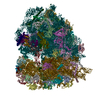
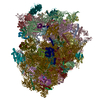
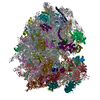
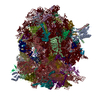
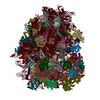
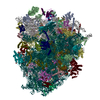
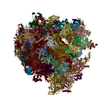
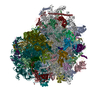
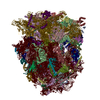
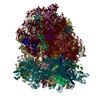
 PDBj
PDBj
























































